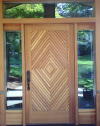

How to Clean Tempered GlassTempered glass also known as safety glass is used in areas that may potentially cause injury to someone if the glass if broken. This type of glass is manufactured through a process of extreme heating and rapid cooling which makes it about four to five times stronger than standard glass. If broken, it will crumble into small cubes instead of sharp dangerous shards.
Identifying Tempered GlassWindows built with safety glass can be found in different areas of a home. Most commonly they are glass doors, sidelights, windows close to the ground, in staircases, skylights, next to tubs and showers (including shower doors), large living room picture windows.Home owner preferences and building codes may vary throughout the country. Most of the time you can identify tempered glass windows by looking in one of the four corners. You should see an etched label that says its tempered or safety glass. Manufacturing ProcessHardened glass is made from annealed glass that goes through a thermal tempering process. The glass is put on a roller table that sends it through a furnace. This furnace then heats it to about 1112 degrees Fahrenheit which is just above its annealing point. Then the glass is rapidly cooled with forced draughts of air while the inner portion of the glass remains free to flow for a short period of time. The ProblemIt is my understanding that containing a sterile environment is crucial to this process. If there are large amounts of dust or other finings that are allowed to come in contact with the glass during the tempering process, imperfections in the surface of the glass are created. These imperfections are usually not visible to the naked eye and do not affect the optical clarity of the glass. Care in Cleaning Tempered GlassExtreme caution should be taken when cleaning tempered glass. Most of these windows but, not all, tend to scratch much easier than normal windows. The reason is due to the rough imperfections that were created in the hardening process. If you were to look through a magnified lens, the imperfections will look like tiny pimples. DamageThe damage tends to happen when an untrained person decides to clean foreign debris off tempered glass. In most cases a window scraper is used to do the job. If used correctly, under normal circumstances these tools will not damage the window. When used on tempered windows with large amounts of imperfections, damage will take place.Tip: Only tools and chemicals listed to clean glass should be used on glass. Anything else may result in damaged glass.
What Happens I will be using the window scraper. as an example because it is most commonly used tool among window cleaners to remove foreign debris from glass. When a cleaning tool such as a window scraper is used on glass with rough imperfections you end up with comet looking scratches everywhere the scraper was used. What happens is the window scraper will cut the rough pimple like imperfections off and will drag them across the surface of the window creating thin hair like scratches. The amount of scratches will depend on the amount of imperfections in the glass. Testing You never know for sure which windows or which side of a window will be a potential problem for scratching. My number one rule is to treat every window as though it may scratch. This means that each window should be tested before a scraper, chemical or any other window cleaning tool is used throughout the entire window cleaning process. First, wet the window with the appropriate window scrubbing tools. Then start by scraping the edge of the window first. Use only about a half an inch pattern. Scrape the same spot three or four times in a row. Feel, listen and look. Feel Feel the scraper as is glides over the surface of the glass. Under normal circumstances it may feel rough for the first or second scrape as it removes debris. After that, it should glide smoothly. If the glass contains rough imperfections, you may continue to feel a rough sand paper like feel each time you scrape. Listen While performing the same test as above, you should listen as well. Again, if the glass contains rough imperfections, you will hear a clicking type sound each time the window scraper is ran over the surface of the wet glass. Look After you have scraped a small portion of an edge, rewet that spot and use a window cleaning squeegee to wipe off the excess water. Then you should examine the glass closely. Look through it from both sides and at different angles to see if any scratches are evident. If you felt roughness, heard clicking sounds and noticed scratches, you can be sure it is tempered glass with rough imperfections and you should not continue that process of cleaning. Window cleaning chemicals may be your next choice.
Tempered Glass
Window Cleaning Secret Solution | Cleaning Window Screens |


















